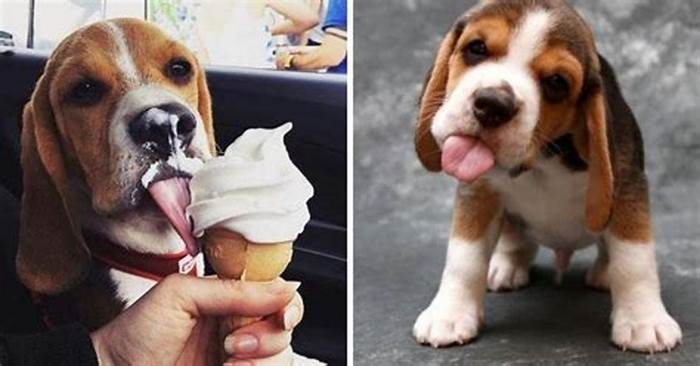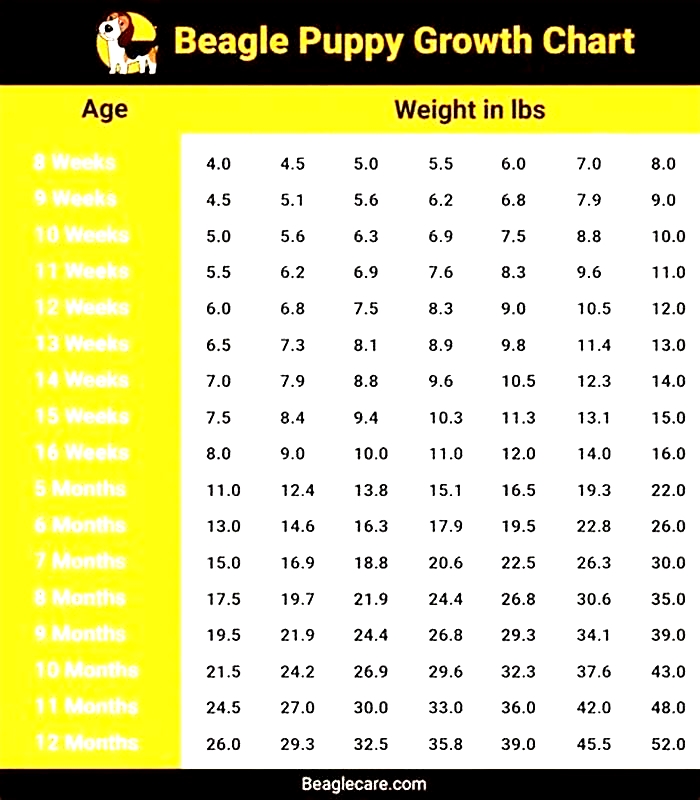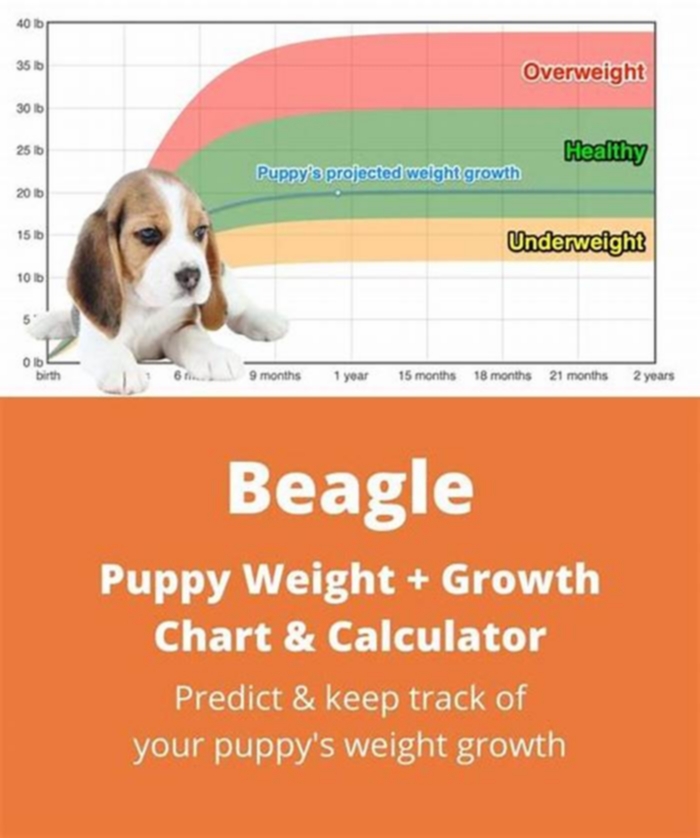How can you tell if a Beagle is purebred

How to identify a Pure-bred Beagle?
Seeing the bond between my dog and me, my neighbor decided to get one beagle, too and started searching for a healthy beagle puppy. A few days back, she came to my door looking all confused and asked me, How the heck should I identify a pure-bred beagle puppy?
By its tail, you can quickly identify whether the beagle is purebred. A purebred beagle will always have white color on the tip of their tail. It could be the entire tail or a few white hairs at the tip. So if you see a beagle without any white in its tail, it is most probably a mixed breed. Another way to identify a purebred is by its paws. All four legs of a purebred beagle are white.
Physical Indicators to identify a Purebred Beagle Puppy
To recognize a pure puppy, the following identifications should be noted carefully:
Tail:As I mentioned above, the easiest way to identify a purebred beagle is by their white tail. Purebred beagles will always have a little while on their tail.
Paws:All the four paws of a pure beagle are white.
Ears: Beagle breed has large fluffy ears that usually end below their face as compared to the other breeds.
Legs:Legs of beagles are usually small compared to their bodies.
White Streak:Mostly, all beagles have a white streak on their heads. Although few mixed-bred beagles also have a white streak on their heads.
Color: Beagles come in different colors, with the two most common being tricolor, which is a combination of black, white, and brown. Again, a few beagle mix breeds also have tricolors. You can read this to learn more about Beagle Colors. By the way, here are some of the rarest beagle colors.
You can watch this video for better understanding:
Behavioral Indicators to identify a Purebred Beagle Puppy
Howling/barking: Beagles are known to be very vocal about their feelings. A pure-bred beagle would make a variety of different sounds to express himself. They howl when they are bored. They bark when they are scared or in pain. They wine when they want your attention. You will start noticing these sounds slowly and gradually after they are two months old.
Sniff: Beagles have excellent noses and love to sniff things. They would smell every new thing they see. Fun fact: Beagles have more scent receptors than most dog breeds.
Training:Beagles are challenging to train, not because they are stupid, but because they are too intelligent to get trained.
Few other ways to identify a purebred beagle puppy
You can always consult a veterinarian. If you need to be 100% sure that your beagle is of pure breed, then you can test his DNA. Results will accurately tell you what bloodline your dog comes from and whether he is a pure or a mixed beagle.
NOTE: While getting your puppy, make sure the breeder hands you over the Kennel Club Registration Certificate and a diet sheet.
How to identify if the Beagle puppy is healthy?
While getting a puppy, it is necessary to check some of the general health considerations. In this way, you can welcome a healthy puppy to your family.
Find out the puppys age.
Every beagle puppy should be kept with their mother and siblings for at least eight weeks. The puppy must learn social behaviors from his parents. It is recommended that the puppy is allowed to be in contact with his littermates and parents for the first 13 weeks.
So try not to separate a puppy from his littermates and get one which is at least eight weeks old.
Puppys hygiene
Check how clean the breeder has kept the puppy. Puppies have low immunity and are more likely to catch an infection. It is essential to keep the puppy clean. There are a few indicators you can look for when you meet a new puppy:
Bright Eyes: The beagle puppys eyes should be clear and bright. A little redness is fine.
Clean Ears:A Beagles ear should be clean from the inside without any redness or scratches. Dirty ears may cause ear infections or even ear mites. If the puppy is constantly scratching his ears, then its a no-go. Another way to identify a puppys ear infection is by smelling his ears.
If you notice a foul odor coming from the puppys ears, then he definitely has an ear infection. Ask the breeder to show the pup to a vet immediately.
Clear Nose: A running nose is a sign of illness. The puppy should not sneeze extensively. Coughing is not a good sign, either.
Examine the puppys coat.
The beagle puppy should have a clean and shiny coating on his body. Bald spots or irritated, red areas on his coat/body are indicators of skin problems or allergies.
Little mud on his body is okay, but if the puppys coat is dirty, stinky, and rough, then he could have worms. So be aware. As soon as you recognize something similar to the pup, let the breeder know about this asap.
You can smoothly part out the puppys fur and take a look at his skin. The skin of the beagle puppy should be clean and smooth as well. Take your time and look for fleas under his coat.
Check his muscles
Examine the pups body and check the muscle definition of his legs. Make sure the puppy has a healthy body and is not thin. Look for his stomach and make sure his belly is not shrunken inside.
Examine the puppys potty.
If possible, have a look at the puppys potty. The puppys stool should be firm. Watery or loose stool is a sign of severe health problems.
If the puppy licks his genital region a lot, then it is an indicator of urinary tract infection.
Notice the puppys energy level.
Mostly, healthy beagle puppies are comparatively more active. You can observe the energy level of the puppy and see how he interacts with you.
Watch his energy level.In addition to the physical symptoms, you should evaluate the overall energy level of the puppy. Watch his interaction with other puppies and see how he interacts with you.
This doesnt mean that calm puppies are not healthy. When I went to the breeder to get a beagle, I had two options; one was quiet and not that interactive, and the other one was very playful and active. I, of course, made the active one a part of my family. A week later, a friend of mine went to the same breeder and got the other calm litter. Its been four years, mine and his both the litters are perfectly healthy.
Get the Vet records of the puppy
Make sure you ask for the past vet records and vaccination certificate of that puppy. If the breeder refuses or cannot give you the records, think twice before getting a puppy from that breeder.
Why is it necessary to learn about the puppys health before getting one?
Raising an unhealthy puppy is very difficult. Sickness during the initial period can leave long-lasting health problems for your beagle puppy. Long-term and continual health problems need constant care. This may also affect the entire family.
Raising an unhealthy pup can get really expensive for you. The overall cost, including the vet and other supply of the first year of a healthy beagle puppy, could go anywhere from $500 to $2000. And for an unhealthy puppy, it may double or even triple the amount. So it is necessary to do proper research about the puppys health before getting one.
How Can You Tell if a Beagle is Purebred? Tips and Tricks to Identify a Purebred Beagle
Have you ever wondered whether your beagle is purebred or not? Its a common question among dog owners who want to know more about their furry friends. The good news is that there are several ways to tell if your beagle is purebred, and its not as complicated as you might think.
One of the easiest ways to determine if your beagle is purebred is to look at their physical characteristics. Beagles are known for their distinct features such as their floppy ears, short tail, and tri-color coat. If your beagle has these traits, then there is a good chance that they are a purebred. You can check their lineage by looking at their pedigree or registration papers if you have them.
Another way to check if your beagle is purebred is through genetic testing. Nowadays, there are several companies that offer DNA testing for dogs. You can simply order a DNA test for your beagle and send a saliva sample to the company for analysis. The results will show if your beagle has any mixed breeds or if they are a purebred. With these easy steps, you can finally put your mind at ease and know for sure if your beagle is a purebred or not.
Physical Appearance of Beagles
Beagles are one of the most beloved dog breeds, known for their loyal, friendly, and adventurous personality. They are highly popular for their distinctive physical characteristics and are often easily recognizable. However, determining whether a beagle is purebred can be a bit challenging, especially for novice dog owners. There are several factors to consider when examining the physical features of a beagle to confirm if it is purebred or not. In this article, we will delve into the different physical characteristics of a beagle to help you understand how to identify a purebred beagle.
- Prominent and Defined Coat Colors
- Size and Weight
- Head Structure and Facial Features
- Paw and Leg Characteristics
- Tail Characteristics
The first and most important physical feature to consider when identifying a purebred beagle is their coat color. Beagles are available in a variety of colors, including lemon, black, red, and white, and often come with a mix of two or three colors. Purebred beagles are known for their prominent and defined coat colors. If your beagles coat is a mix of various colors, it may not be purebred.
Another factor to consider is their size and weight. Purebred adult beagles typically weigh between 20 to 30 pounds and stand at a height of 13 to 15 inches. Any deviations from this standard may indicate that the beagle is not purebred.
The head structure and facial features are also crucial in determining whether a beagle is purebred or not. Purebred beagles have a well-defined and proportionate head, with long droopy ears that are at least halfway down their necks. Their face should be proportionate to their head and not be too narrow or too pointed.
The paw and leg characteristics are also essential when identifying a purebred beagle. Purebred beagles have straight and proportionate paws, and their legs are well-sculpted with a muscular build that complements their body structure.
Lastly, their tails are also useful in identifying purebred beagles. A purebred beagle should have a straight tail that is neither too thin nor too thick, with white at the tip, which is one of the physical characteristics that differentiate them from other hound breeds.
| Physical Characteristics | Purebred Beagle | Non-Purebred Beagle |
|---|---|---|
| Coat Colors | Prominent and defined color mixture | Mix of various colors |
| Size and Weight | 20-30 pounds and 13-15 inches in height | Deviations from the standard |
| Head Structure and Facial Features | Proportionate head and face, droopy long ears | Narrow head or pointed face |
| Paw and Leg Characteristics | Well-sculpted, muscular, proportionate paws | Too thin or too thick paws |
| Tail Characteristics | Straight tail with white tip | Crooked tail or non-white tip |
In conclusion, determining whether a beagle is purebred or not requires careful examination of their physical features. While this task may seem daunting at first, knowing the distinct characteristics of purebred beagles will give you the confidence you need when identifying your furry friends lineage.
Characteristics of Purebred Beagles
Beagles are one of the most recognizable dog breeds in the world. Their curious and friendly disposition makes them a popular choice for families and individuals alike. However, when looking to adopt or purchase a beagle, its important to know how to determine whether or not they are purebred. Here are some characteristics of purebred beagles:
- Their coat color is typically tricolor: black, tan, and white. While there are variations in color, such as lemon or red, tricolor is the most common.
- They have a white tip at the end of their tail, known as the flag.
- Beagles are a small to medium-sized breed, typically weighing between 18-30 pounds.
While these characteristics can help identify a purebred beagle, there are additional steps you can take to ensure you are adopting or purchasing a healthy and authentic beagle.
First and foremost, make sure to work with a reputable breeder or animal rescue organization. They should be able to provide documentation of the dogs lineage and any health checks or vaccinations they have received. Additionally, you can ask to see the parents of the beagle to further verify their purebred status.
If you are unsure whether your beagle is purebred, you can also consider DNA testing. This can provide comprehensive information about your dogs breed and ancestry.
| Characteristic | Description |
|---|---|
| Coat color | Tricolor: black, tan, and white |
| Tail | White tip at the end, known as the flag |
| Size | Small to medium-sized breed, typically weighing between 18-30 pounds |
By understanding the characteristics and taking necessary steps to ensure your beagles purebred status, you can acquire a loving and loyal companion that will bring joy to your life for years to come.
Differences between Purebred and Mixed-breed Beagles
Beagles are one of the most loved dog breeds in the world. However, there are differences between purebred and mixed-breed beagles, and its important to understand them before getting one as a pet. Here, we focus on the differences between the two:
- Genetic Purity: A purebred beagle is a dog whose parents are of the same breed while a mixed-breed beagle is a dog of two or more breeds. With purebred dogs, their genetic history can be traced, and you can know what to expect from them. On the other hand, mixed-breed beagles have a more unpredictable nature as far as their behavior and traits are concerned.
- Availability: Purebred beagles are easier to find than mixed-breed beagles. This is because there are specialized breeders who focus on rearing purebreds. However, mixed breed beagles are usually found in animal shelters.
- Health: Purebred beagles have fewer health issues than mixed-breed beagles. This is because, with mixed-breed beagles, there are chances of inheriting the health issues of different breeds. While purebred beagles may develop certain health problems, such as hip dysplasia or hypothyroidism, measures can be put in place to prevent them.
Therefore, if you want a beagle, you must decide whether you want a purebred or mixed-breed one. If you opt for a mixed-breed beagle, its important to keep in mind that they will have traits and behavior that may be different from what you were expecting.
Its also important to note that the looks of a purebred beagle may vary. Although purebreds generally have a distinct appearance, there can be variations in physical traits such as color, size, and coat texture. To avoid getting ripped off by someone trying to pass off a mixed-breed as a purebred, you must know the distinguishing traits of purebred beagles. You can tell if your beagle is purebred through:
| Trait | Purebred | Mixed-breed |
|---|---|---|
| Size | 13-15 inches at the shoulder | Varies depending on the breeds mixed |
| Color | White-tipped tails and black spots on the body | Varies depending on the breeds mixed |
| Temperament | Friendly, curious, or even-tempered | Varies depending on the breeds mixed |
By knowing the distinguishing traits of a purebred beagle, you can tell if someone is trying to pass off a mixed-breed as a purebred. Its always advisable to buy a beagle from a reputable breeder that has a good track record.
Pedigree Verification for Beagles
If youre considering getting a beagle, you may be wondering how to tell if theyre purebred. One way to verify their lineage is through pedigree records. A pedigree is a document that provides information about the beagles ancestors, including their names, registration numbers, and titles earned in competitions or shows.
- To obtain a pedigree, youll need to contact the breeds national registry or a breed club that specializes in beagles. They will provide you with an application to submit to register your dog with them. The pedigree will be prepared and sent to you after your dog has been approved for registration.
- Once you receive the pedigree, you can examine the document to see if all the names and registration numbers match up with your dogs lineage. You should also look for any titles earned by the beagles listed on the pedigree.
- Its important to note that while a pedigree is a good indication of a beagles lineage, it doesnt guarantee that theyre purebred. False pedigrees do exist, so its essential to do your research and choose a reputable breeder.
If youre considering adopting a beagle from a rescue organization or shelter, its unlikely that youll have access to a pedigree. In this case, you can look for physical characteristics that are typical of the breed, such as their size, color, and coat type. Additionally, many rescue organizations conduct DNA tests on their dogs to determine their breed makeup, which can give you a better idea of whether or not theyre purebred.
If youre still unsure if your beagle is purebred after examining their pedigree or physical characteristics, you can opt for a DNA test. There are several DNA test kits available online that can identify a beagles breed makeup by comparing their DNA to a database of known breeds.
| Pedigree Verification Checklist: | Non-Purebred Verification Checklist: |
|---|---|
| Obtain a pedigree from a reputable source | Look for physical characteristics typical of the breed |
| Examine the pedigree for matching names and registration numbers | Consider DNA testing |
| Look for titles earned by the beagles listed on the pedigree |
By following these steps, you can have a better understanding of whether or not your beagle is purebred. Whether youre purchasing a beagle from a breeder or adopting one from a rescue organization, its important to take the time to verify their lineage to ensure youre getting the most accurate information possible.
DNA Testing for Beagles
When it comes to determining whether or not your Beagle is purebred, there are a few methods you can utilize but the most dependable will always be a DNA test. Through DNA testing, breeders and owners alike can verify a dogs lineage and ensure that a pup is purebred with a high degree of accuracy. One of the best methods for Beagle DNA testing is to use a cheek swab or blood sample.
- Cheek swab test: A swab is taken from the inside of your pups cheek using a long cotton swab. The swab is then sent in for testing, and results can take anywhere from a few weeks to a few months to get back. Cheek swab tests can be purchased online or through a veterinarian.
- Blood sample test: Blood samples are taken by a vet and sent in for testing. This test is considered the most accurate because blood samples contain more DNA, and fewer mistakes are made in the analysis process.
- Parental verification: If you are breeding your Beagles, you can also have the parentage of a pup tested, which can determine if they are purebred or not.
The information provided by DNA testing allows breeders to confirm the lineage of a Beagle, which is important when it comes to breeding purebred dogs. It can also help owners identify potential health issues that may arise due to the dogs breed. Beagle owners, in particular, should be aware of the following genetic conditions:
- Hip dysplasia
- Cherry eye
- Intervertebral disc disease (IVDD)
- Ear infections
By understanding the genetic predisposition of a particular dog breed, owners can take steps to prevent or treat certain medical conditions.
| Test name | Price | Accuracy | Turnaround time |
|---|---|---|---|
| Wisdom Panel Essential DNA test | $99.99 | 90% | 2-3 weeks |
| Embark Breed Identification Kit | $129 | 95% | 3-5 weeks |
| VetGen DNA Paternity Test | $55 for dam, $25 per sire | 99.9% | 2-3 weeks |
There are many DNA testing services available for dogs, and the prices and accuracy rates can vary. Generally, the more you pay, the better the accuracy and turnaround time. Two popular companies for Beagle testing include Wisdom Panel and Embark. Some test results will show your dogs predisposition for certain health conditions, and owners can use this information to proactively manage their pets health.
Choosing a Reputable Breeder for a Purebred Beagle
When it comes to getting a purebred Beagle, choosing the right breeder is crucial. Not all breeders are the same, and some may prioritize profit over the health and well-being of their dogs. Here are some tips on how to find a reputable breeder:
- Research breeders in your area: Look for local Beagle clubs or associations and ask for recommendations. Read online reviews and check the breeders social media presence.
- Visit the breeder and meet the dogs: A reputable breeder should be open to letting you meet their dogs and see their living conditions. Observe the dogs behavior and ask the breeder questions about their breeding practices.
- Ask for health clearances: A responsible breeder will have their breeding dogs tested for potential genetic health issues. Ask for documentation of these clearances.
Once youve found a breeder you trust, its important to know what to look for in a purebred Beagle.
One way to tell that a Beagle is purebred is by its physical characteristics. Here are some traits to look for:
| Traits | Description |
|---|---|
| Size | Beagles typically weigh between 20-30 pounds and stand at around 13-15 inches tall at the shoulder. |
| Coat | Beagles have a short, dense coat that is usually a combination of black, brown, and white. |
| Head Shape | Beagles have a distinctive head shape with long ears and a square muzzle. |
| Behavior | Beagles are friendly, curious, and energetic dogs. They are known for their loud baying bark and love to explore. |
However, physical traits alone are not always reliable indicators of a purebred Beagle. DNA testing can provide definitive proof of a dogs breed. Some breeders may even offer DNA testing for their puppies.
Ultimately, the best way to ensure that youre getting a purebred Beagle is to do your research and choose a reputable breeder who prioritizes the health and well-being of their dogs.
Common Misconceptions about Purebred Beagles
Beagles are a beloved breed of dog, known for their cute looks and friendly personalities. However, there are many misconceptions about purebred Beagles that can mislead potential dog owners. In this article, we will explore these myths and provide you with the truths you need to know to make informed decisions about owning a purebred Beagle.
Myth #7: Beagles are not purebred if they have blue or green eyes.
This myth likely stems from the fact that blue or green eyes are not the typical eye color for Beagles. However, it is entirely possible to have a purebred Beagle with blue or green eyes. Eye color is determined by genetics and can vary between different lineages of the same breed.
If youre unsure if your Beagle is purebred, there are other physical characteristics you should look for. Beagles typically have a white-tipped tail and can be any combination of black, tan, and white in color. They are also known for their floppy ears and gentle, curious expressions.
To be sure that your Beagle is purebred, you can have them DNA tested. This test analyzes your dogs DNA to determine its breed history and ancestry. Its a relatively straightforward process that can provide you with peace of mind about your dogs lineage.
| Physical Characteristics of a Purebred Beagle | |
|---|---|
| White-tipped tail | |
| Black, tan, and white in color | |
| Floppy ears | |
| Blue or green eyes |
Overall, its essential to separate fact from fiction when it comes to owning a purebred Beagle. By doing your research and understanding the physical characteristics of the breed, you can ensure that youre making the best decision for you and your family.
FAQs: How Can You Tell If a Beagle is Purebred?
1. What is a purebred beagle?
A purebred beagle is a dog that has parents of the same breed and comes from a long line of purebred beagles.
2. Why should I care if my beagle is purebred?
Knowing if your beagle is purebred can help you determine their potential size, temperament, and health issues they may be prone to.
3. How can I tell if my beagle is purebred?
You can check for physical characteristics such as the dogs size, head shape, and coat color, or you can get a DNA test to confirm their breed.
4. What are some physical characteristics of a purebred beagle?
A purebred beagle should have a white-tipped tail, drooping ears, and a black, white, and tan coat that is short and glossy.
5. Can a beagle be purebred if it doesnt have papers?
Yes, a beagle can still be purebred even without registration papers. However, papers can provide verifiable proof of a dogs lineage.
6. What should I do if I suspect my beagle is not purebred?
If you suspect your beagle is not purebred, you can get a DNA test to confirm their breed or speak with a reputable breeder or veterinarian for their opinion.
7. Can I adopt a purebred beagle from a shelter?
Yes, it is possible to adopt a purebred beagle from a shelter. However, you may need to do some research and ask the shelter if they have any purebred beagles available.
Closing Thoughts: Thanks For Reading!
We hope these FAQs have helped you better understand how to tell if a beagle is purebred. Remember, physical characteristics and DNA tests are reliable methods to confirm breed. If you have any further questions, please feel free to reach out to a breeder or veterinarian. Thanks for reading and until next time, take care and keep wagging those tails!








